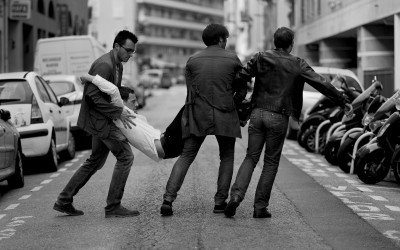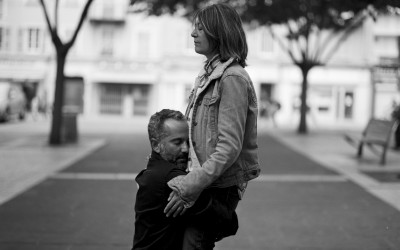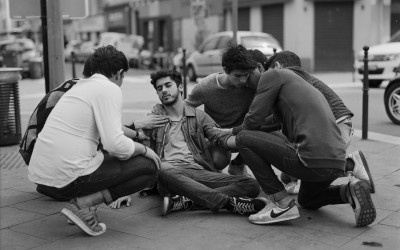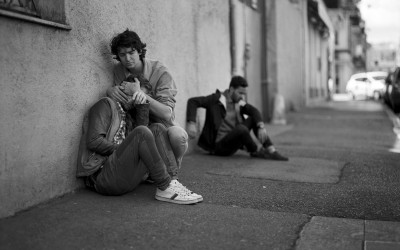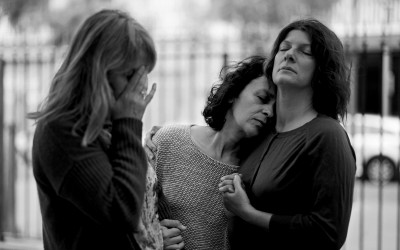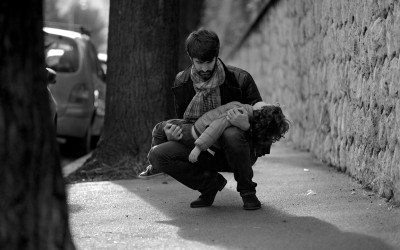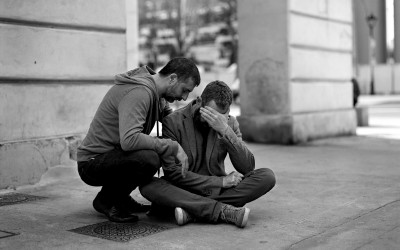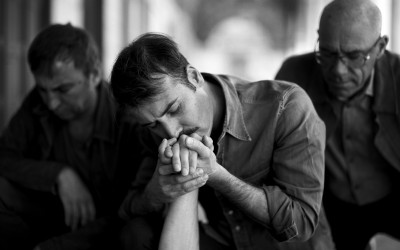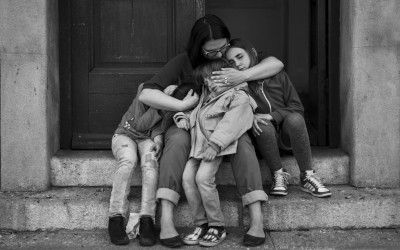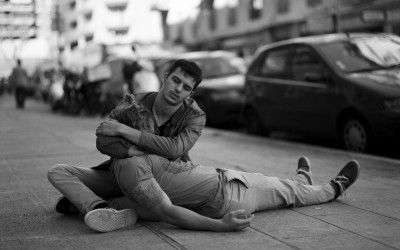« Je consulte beaucoup d’images. Sur Internet. Des images dites de presse, des reportages à dimensions politiques ou sociales. (…) Depuis un peu plus d’un an, je me suis concentré sur des images de guerre liées à l’actualité. Les conflits au Moyen-Orient. Surtout la Syrie et la Palestine. (…) Je me suis constitué ainsi une sorte de banque d’images des civils pris dans la guerre. C’est important pour moi cette notion de civil. Je me suis aperçu qu’il y avait des images récurrentes. Celle d’un homme par exemple, qui sort des gravats, après une explosion ou un bombardement, et qui tient un enfant dans ses bras. (…) J’en ai fait une première photo : un homme qui marche. Il porte son enfant dans ses bras. Ils sont recou- verts de poussière. (…)
Je ne cherche pas à refaire des images. Ce qui compte pour moi, ce qui est au cœur du projet, c’est cette question de l’identification. Comment je m’identifie aux victimes ? Com- ment le spectateur s’identifie à l’image ? Est-ce qu’on s’identifie à ces images de guerre au Moyen-Orient ? Est-ce qu’on ne s’identifie pas davantage aux images du conflit en Ukraine ? ou en Yougoslavie ? Ce sont toujours les mêmes images. Ce sont exactement les mêmes scènes. Pourtant, on ne s’identifie pas de la même façon. Notre regard ne bascule pas dans l’image de la même manière. C’est cette bascule, ce pouvoir d’identification qui m’intéresse.(…)
Je travaille souvent la mise en scène. C’est quelque chose de très lourd techniquement. Il y a un travail de repérage, de choix des personnages, des accessoires, des vêtements. Et surtout un travail sur la lumière. Pour cette série, j’ai voulu travailler à l’inverse. Au moyen-format, mais à main levée, sans trépied, à la lumière du jour, quasiment sans repé- rage, avec des personnes ordinaires, de mon entourage. Je voulais alléger la mise en scène au maximum. Les gens viennent comme ils sont. La seule mise en scène finalement, c’est la mise en scène des corps. Je ne les fais pas jouer. Ils ont simplement les yeux fermés. Pas de cris, pas de pleurs, pas de sang sur le visage. Ils n’ont aucune expression(…) J’ai utilisé le noir et blanc pour mettre de côté les questions de la couleur. Ça m’a aussi permis de rendre l’image plus lisse, sans aspérités. Il y a aussi un caractère d’étrangeté, un décalage entre la scène et le lieu : un paysage urbain anonyme, générique, sans indices de la guerre.(…)
Quand j’ai commencé cette série, j’ai envoyé les premières images à un ami photographe, Sebastien Godefroy. Il m’a fait remarqué qu’elles lui faisaient immanquablement penser aux attentats de Novembre, à Paris. (…) Justement, ces images on ne les avait pas vues. On ne les a pas eues. On a bien eu quelques images, mais très peu. Quelques vidéos tournées au téléphone portable. Cette jeune femme notamment, enceinte, accrochée à une fenêtre. Et c’est tout. On a eu les images d’après. Une fois que les secours étaient intervenus. (…) C’était pourtant bien la guerre. (…) ça rejoint ce questionnement sur le droit à l’image des victimes. Ici, on protège l’identité et la douleur des victimes au nom du droit à l’image, quand ailleurs on dénie ce droit au nom du devoir de témoignage. (…) »
Entretien : Karim Ghelloussi / Florent Mattei (A l’occasion de l’édition « Le monde ou rien » | Mai-juin 2016 | Circonstance Galerie)
I examine a lot of pictures. On the Internet. Pictures that are labelled as press images, from reports, with political or social dimensions. (…) For more than a year, I have been focusing of war pictures linked to the news. The Middle-East conflicts. Especially Syria and Palestine. (…) I therefore built a kind of bank of images with civilians caught in war. This notion of civilian is important to me. I noticed there were recurring pictures. One of a man, for example, coming out of rubbles, after an explosion or a bombing, and who holds a child in his arms. (…) I did a first photograph with it : a walking man. He holds his child in his arms. They are covered in dirt. (…)
I do not try to re-make images. What matters to me, what is at the heart of the project, is this question of identification. How do I identify myself to the victims? How does the viewer identify him or herself to the picture ? Can one relate to these pictures of the Middle-East war ? Doesn’t one relate more to the pictures of the conflict in Ukraine ? Or in Yugoslavia ? These are always the same pictures. They are exactly the same scenes. Nevertheless, one does relate to them in the same way. This shift, this power of identifying are what keep me going (…)
I often work on the setting. It is something technically very heavy. There is a work on the site locating, on the choice of characters, of props, of clothes. And above all, a work on lighting. For this series, I wanted to work the other way around. Using medium-size, without a tripod, freehanded, with daylight, with almost no site locating, with ordinary people, from my surroundings. I wanted make the setting as light as possible. People come as they are. The only setting in the end is the setting of the bodies. I do not make them act. Their eyes are simply closed. No yelling, no crying, no blood on their face. They have no expression (…) I used black and white to leave the questions of colour aside. It also allowed me to give a smoother aspect to the pictures, without rough edges. The is also a strange side to them, a shift between the scene and the site : a urban anonymous, all-encompassing background, with no sign of a war. (…)
When I started this series, I sent the first pictures to a friend photographer, Sebastien Godefroy. He pointed out that they inevitably reminded him of the November attacks in Paris. (…) Precisely, we had not seen these pictures. We did not get them. We did get some pictures, but very few. Some videos taken with a mobile phone. This pregnant young woman, in particular, hanging to a window. And that’s all. We had got the pictures of after the event. Once the emergency services had intervened. (…) Nevertheless that was war. (…) It connects with this question of the image rights of the victims. Here, we protect the identity and the grief of the victims in the name of image right, when elsewhere, we deny this right in the name of the duty of testimony. (…) »
Interview : Karim Ghelloussi/Florent Mattei (On the occasion of the edition « Le monde ou rien » / May- June 2016 / Circonstance Galerie)
De la série « Ici entre les débris des choses et le rien … » 10 photographies tirages argentiques baryté dimensions variables
From the series « Ici entre les débris des choses et le rien … » 10 barium silver photographs, varying sizes.

